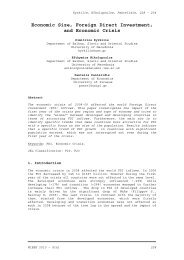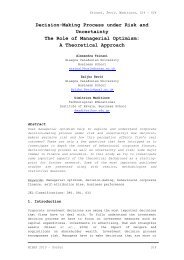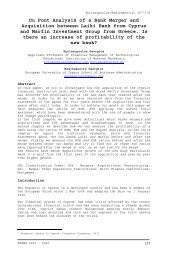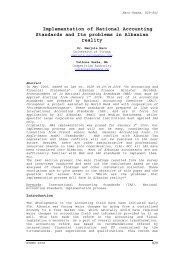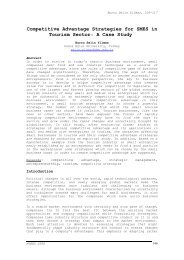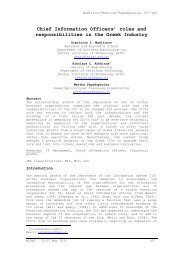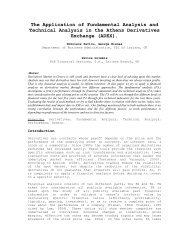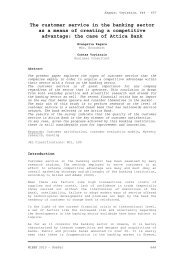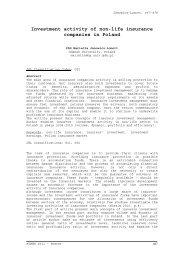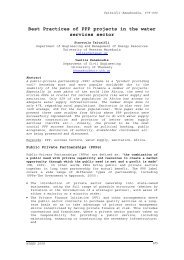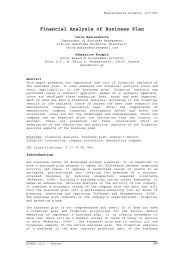Editorial And Advertising Mix. Readers' Perceptions The ... - mibes
Editorial And Advertising Mix. Readers' Perceptions The ... - mibes
Editorial And Advertising Mix. Readers' Perceptions The ... - mibes
Create successful ePaper yourself
Turn your PDF publications into a flip-book with our unique Google optimized e-Paper software.
Alexopoulos-Blanas, 276-290<br />
advertorials may be more misleading than editorials . Probably the<br />
greater acceptation to the advertorials has to do w ith their<br />
structure and the placement (Prounis 2004) inside the magazine.<br />
(Placement before the first issue and before the la st one) <strong>The</strong> third<br />
outcome has to do with magazines characteristics. I n each case<br />
readers seem to believe in the quality of Kapa styl e magazine (Appel<br />
2000), its theme features and structure. This outcome is given by a<br />
grant mean of M=4.03 in a five point scale. In this part questions<br />
that had to do with the appreciation to structure a nd theme issues<br />
that are relevant with the quality of the print med ia. <strong>The</strong> fourth<br />
and last outcome of this investigation is focused o n readers’ groups<br />
as potential product customers. In every case reade rs probably<br />
believe with a mean of M=3.78 that placement of bra nd inside theme<br />
features has some cost for the advertisers. Another great aspect that<br />
is found is readers’ segmentation per age, sex, occ upation and<br />
educational level. Each one of the previous reader- factors defines<br />
some of the audience characteristics. A basic assum ption of this<br />
investigation is the sample’s structure that is bas ed on subscribers’<br />
data bases. <strong>The</strong> subscribers sample was chosen due t o the assumption<br />
of its homogeneity. Its own homogeneity is proved b y the common norm<br />
and direction of readers’ perceptions in every case . Although the<br />
common reactions, readers per group tent to react m ore or less close<br />
to the middle of the five point scale. For those re asons, an extended<br />
analysis to the variances of every group was made.<br />
Sex level analysis<br />
Women’s reactions generate more attention and ap<br />
men’s ones, while men have higher levels of accepta<br />
magazine.<br />
preciation than<br />
nce for the<br />
Education level analysis<br />
High school graduates give more attention to the me features and<br />
advertorials than every other educational group. It is observed that<br />
as we move to higher educational level, attention o f the group has<br />
lower prices. About theme information and amusement , lyceum graduates<br />
have the first place followed by high school gradua tes, university<br />
degree graduates and final Master or PhD owners. I n case of<br />
advertorial information as the educational level gr ows up, the degree<br />
of information falls. Lyceum graduates have the fir st place on<br />
advertorial amusement with second the university gr aduates and then<br />
the high school graduates and Master or PhD owners. <strong>The</strong> first place<br />
for advertisements information is held by Lyceum gr aduates and the<br />
second from high school graduates. University degre e and Master or<br />
PhD owners seems not to be so interested from the a dvertisements’<br />
information. Advertisements seem to amuse more univ ersity and lyceum<br />
graduates and less high school graduates and higher educational level<br />
readers. <strong>The</strong> amusement for advertorials and adverti sements is higher<br />
to middle and high level of education and gets lowe r to basic and<br />
higher educational level. <strong>The</strong> irritation level for editorial,<br />
advertorial and advertisements falls as the educati onal level grows.<br />
<strong>The</strong> acceptance for editorial is higher on lyceum an d Master or PhD<br />
level and lower on university and high school level . <strong>The</strong> advertorial<br />
acceptance level is higher in higher level of educa tion and falls as<br />
educational level declines. Higher or middle educat ional level<br />
respondents tent to feel more misleading for editor ials than high or<br />
low educational level readers. <strong>The</strong> misleading degre e for advertorials<br />
is higher for higher level of education and decline s to lower levels.<br />
MIBES 2011 – Oral 284



